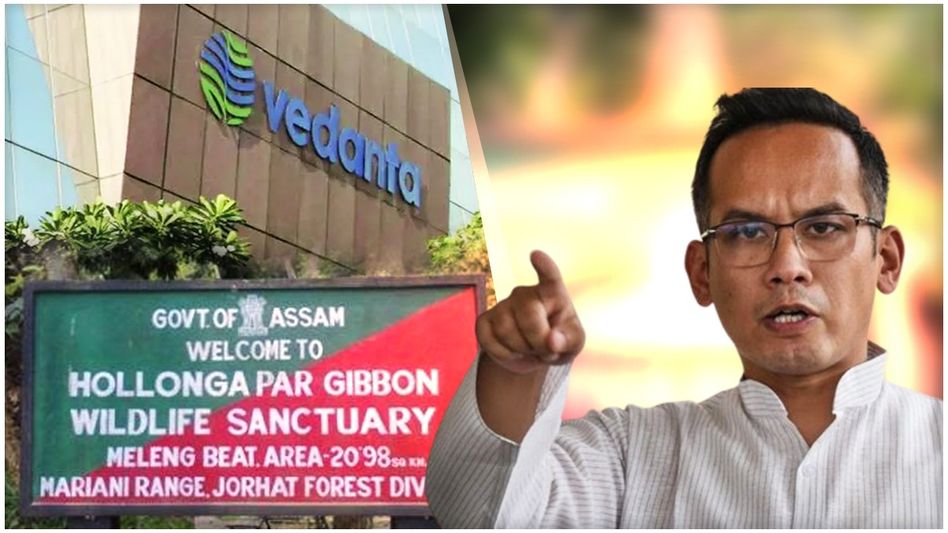Gaurav Gogoi slams Assam government’s approval for Vedanta project, says BJP compromising environment to favour business group
The Hollongapar Gibbon Sanctuary, previously recognized as the Gibbon Wildlife Sanctuary or Hollongapar Reserved Forest, is a dense evergreen forest located in the eastern part of Assam's Jorhat.
 Gaurav Gogoi slams Assam government’s approval for Vedanta project, says BJP compromising environment to favour business group
Gaurav Gogoi slams Assam government’s approval for Vedanta project, says BJP compromising environment to favour business groupThe Assam government has granted approval for a new mining project by Vedanta's subsidiary, Cairn Oil and Gas in an area that encompasses the Hollongapar Gibbon Wildlife Sanctuary in Jorhat. This sanctuary is a critical habitat for the endangered Hoolock Gibbons and wild elephants.
The Hollongapar Gibbon Sanctuary, previously recognized as the Gibbon Wildlife Sanctuary or Hollongapar Reserved Forest, is a dense evergreen forest located in the eastern part of Assam's Jorhat. Established as a sanctuary in 1997, it comes under the government-approved category and was primarily declared a Reserved Forest way back in the year 1881, with fruits and various species of trees extending to the foothills of the Patkai mountain range.
Since then, over the years, the sanctuary has grown isolated and sandwiched by the tea plantations and the small villages that surround the area. An exceedingly interesting relict population evolved during reafforestation attempts made in the early part of the last century in a modified habitat. The area harbors species such as the hoolock gibbons, the only apes of India and the Bengal slow loris, which is the only nocturnal primate in Northeast India.
The project, which involves diversion of 4.49 hectares of forest land awaits a clearance from the Forest Advisory Committee of the Union Environment Ministry has also drawn flak from a host of wildlife experts and environmentalist who feel that the scheme poses a severe threat to the sanctuary's delicate ecosystem.
While speaking on this issue, Chief Wildlife Warden Sandeep Kumar said that the sanctuary was important since it formed a crucial corridor for the wild elephants. Therefore, from whatever angle one looks at it, the project is essential on national importance. But the same is conditioned to the following factors to cut down the environmental impacts. This involves a reduction in the number of trees to be axed, ensuring that there is no pollution and taking care of the dangers posed by leaking oils and blasts.
Further, the project will have to contribute 2 per cent to the total project cost to the wildlife conservation and in resolving the human-animal conflicts by ensuring sufficient measures are taken to protect the delicate ecosystem of the sanctuary against the unsustainable developments that will be experienced.
Assam Congress MP Gaurav Gogoi speaking to India Today NE said that the Assam government has been propagating double standards over wildlife and other environmental issues. He alleged that while the government talks of wildlife protection, at the same time, it tows policies that are radically detrimental to the interests of the indigenous community and the environment.
"The government's approach is to remove the poor and displace indigenous tribes of Assam of the right to life in their traditional forest areas. But they will turn a blind eye to the destruction of the wild life and forests if it benefits large private mining companies of big businesses. The inference appears that big mining companies are the stakeholders for the BJP government whereas indigenous tribes and environmental concerns are secondary issues," Gogoi said.
Gogoi took serious exception to the ecological damage that may be caused to this isolated forest covering an area of about 2,098.62 hectares. It is pointed out that the isolation of the sanctuary is already a major difficulty in conservation, as it is surrounded by vast tea gardens and small hamlets. The further fragmentation of the habitat due to mining activities will pose a serious threat to the already fragile ecosystem of the sanctuary and the endangered species within.
He had further expressed doubts at the motives of the BJP as the party might have entered into secretive deals with the mining companies in view of the state elections to be held two years from now. "I am critical of this project and do not support it. The BJP seems to be giving more importance to electoral donations, compromising on environmental concerns. Given the elections coming up, there's a suspicion that the BJP has entered into a secret deal with big mining companies."
Gogoi opposed the project, citing reasons of endangerment of many species, including the endearing and endangered Hoolock Gibbons. "This project is posing a significant danger to the ecology, groundwater, air quality and waste management. We have seen this happening in many instances before, like the one explosion on the Bhajan oil reserve. I am not sure that we have been able to restore the ecology from that blast properly
He even lashed out at the Assam Wildlife Department for reportedly supporting the illegal activities: "The department has been facilitating the tree mafia and private resorts owned by political leaders, rather than protecting the environment. They have done nothing to safeguard our ecology".
Dr. Jihosuo Biswas, a stalwart researcher on wildlife and primatologist speaking to India Today NE said that the proposed mining project in Assam had raised apprehension respecting the likely impact it would have on the surrounding environment and wildlife, more particularly the Hoolock Gibbons.
As proposed by , "The mining they want to undertake is either deep inside the forest or just outside a small protected area, less than 20 square kilometers. Though the specific area is not mentioned, the project is about Cairn Oil and Gas, which is into Vedanta, wanting the diversion of 4.49 hectares of forest land for oil and gas exploration in Jorhat, Assam, which is currently pending before the Environment Ministry."
Dr. Biswas said that under government guidelines no activities like drilling or minining are allowed in a protected area and therefore, if at all the project falls beyond that zone, it would also have to cater to the environmental norms.
He said, "If the project lies away from that protected area, then naturally it cannot directly affect the Hoolock Gibbons. But, considering it is in or near the safe zone, that would be very bad for gibbons: "Gibbons are sensitive and have large home ranges."
Dr Biswas said, "Gibbons are highly sensitive animals. We need to make sure their habitat is maintained and grows because its population is already under severe pressure." He said that if the project site is in the Dessoi Valley RF, the impact could be minimal. "If the project site lies in the Dissoi Valley Reserve Forest, which according to reports is already encroached and is less critical to the habitat of the gibbons, the impacts could be minimal. But it will have grave implications if it's within or close to the Hoollongapar Gibbon Wildlife Sanctuary.", he added.
Renowned Slow Loris expert Dr Nabajit Das spoke to India Today NE and said, "Definitely, the mining will affect not only the Hoolock Gibbons but all the wildlife of the area. The impact of the project will be tremendous.
Dr. Das added, "The area is very small. In such a confined space, any disturbance will harm the entire ecosystem."
Copyright©2025 Living Media India Limited. For reprint rights: Syndications Today









